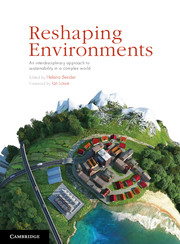Book contents
- Frontmatter
- Contents
- Contributors
- Acknowledgements
- Introduction Reshaping environments – an opportunity for envisioning the future
- Part 1 Cases
- 1 Costa Rica’s dry north-west
- 2 Reshaping land transport in Singapore
- 3 Evaluating different ways of managing forested landscapes
- 4 Changing the landscape management paradigm with farmers
- 5 Meeting development goals without blowing your carbon budget
- 6 The EGLE has landed
- 7 Reshaping the Murray-Darling Basin, Australia
- 8 Burning questions
- Part 2 Skills
- Part 3 Theory
- Index
- Plate Section
- References
1 - Costa Rica’s dry north-west
A region in transition
from Part 1 - Cases
Published online by Cambridge University Press: 05 February 2013
- Frontmatter
- Contents
- Contributors
- Acknowledgements
- Introduction Reshaping environments – an opportunity for envisioning the future
- Part 1 Cases
- 1 Costa Rica’s dry north-west
- 2 Reshaping land transport in Singapore
- 3 Evaluating different ways of managing forested landscapes
- 4 Changing the landscape management paradigm with farmers
- 5 Meeting development goals without blowing your carbon budget
- 6 The EGLE has landed
- 7 Reshaping the Murray-Darling Basin, Australia
- 8 Burning questions
- Part 2 Skills
- Part 3 Theory
- Index
- Plate Section
- References
Summary
Introduction
When cattle farmers in Costa Rica’s dry north-west are asked how things have changed over the last 30 years, their reply is: ‘Todo es diferente: Todo, todo, todo.’ ‘Everything is different: Everything, everything, everything’. This chapter reports on the work of a PhD student who went to this region in 2007 to find out why forests were growing back there and what it meant for sustainability. However, a lot more was changing than just the forest cover. Important aspects of the region’s society, economy and culture were rapidly transforming in ways that both challenged and supported its sustainability at the same time. Pursuing sustainability in this place would involve much, much more than just growing back forests.
The dominant land use in Costa Rica’s dry north-west has traditionally been cattle-farming on large ranches (called haciendas in Spanish). However, just as the cattle farmers had said: today ‘everything is different’. Very few large haciendas remain, replaced mostly by smaller farms and in some cases national parks. The government now has a scheme that pays farmers to conserve forest and to reforest old cattle pastures. Tourism has replaced cattle as the main economic activity.
- Type
- Chapter
- Information
- Reshaping EnvironmentsAn Interdisciplinary Approach to Sustainability in a Complex World, pp. 17 - 44Publisher: Cambridge University PressPrint publication year: 2012



